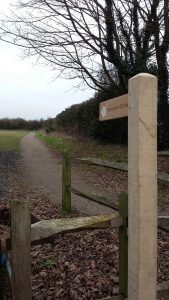Because of poor signage the equestrian use of this BW has been questioned by other users.
Through the multi-year efforts of Chris Smith the path has not only been cleared of encroaching vegetation but is now FINALLY SIGNED PROPERLY
In mid February 2017 two new permissive bridleway signs were installed by the team at Stanmer Park; one at either end of the route. 
SDNPA say that they “hope that the addition of this signage will put an end to any doubts over permission for horse riders to use it. …… the path itself is not the responsibility of the National Park Authority and the issue of its adoption as a bridleway by ESCC remains outstanding.
A brief history of the Falmer- Woodingdean path
Some years ago ESCC held a consultation on the spending of cycle funding paid under the Sustainable Communities Fund. It was decided to use part of this money to create a bridleway parallel to the road between Woodingdean and Falmer- or so the consultation claimed. The way was to be used by pedestrians, equestrians and cyclists. The national park is the lead co-ordinator for this route.
The north part of this route replaced a permissive bridleway which was an important link between bridleways south of the A27 and those to the north. There are, of course few crossings of the A27 suitable for equestrians. However equestrian interests did not object to the removal of this permissive route because a longer route with statutory rights was being created. However this did not happen!
Instead signs were erected showing the route as being accessible only to pedestrians and cyclists. As a result of this horse riders were subject to abuse and complaints from cyclists when taking horses down the route. For a short period after the route opened it was wished to keep horses off of the route until it had settled. However after this period was long gone the signage still showed walker and a cyclist silhouettes only.
ESCC would not initially take on responsibility for the route because it had been built to such a poor standard, but subsequently felt that the path was in a state where it would not be damaged by equestrian use and that there was no reason why it should not be opened to equestrians. They said they would arrange this – but didn’t!
Chris pursued the SDNPA as equestrians were being deterred from using an important route that they had used for many years due to the actions and inaction of the National Park.
He pressed that the park ensure that signs welcoming equestrians were put in place at the start and finish of the route and at junctions with bridleways. The start and end signs are at last in place.
BUT: We all should press that full statutory bridleway status be granted for this BW to preserve it in perpetuity.

